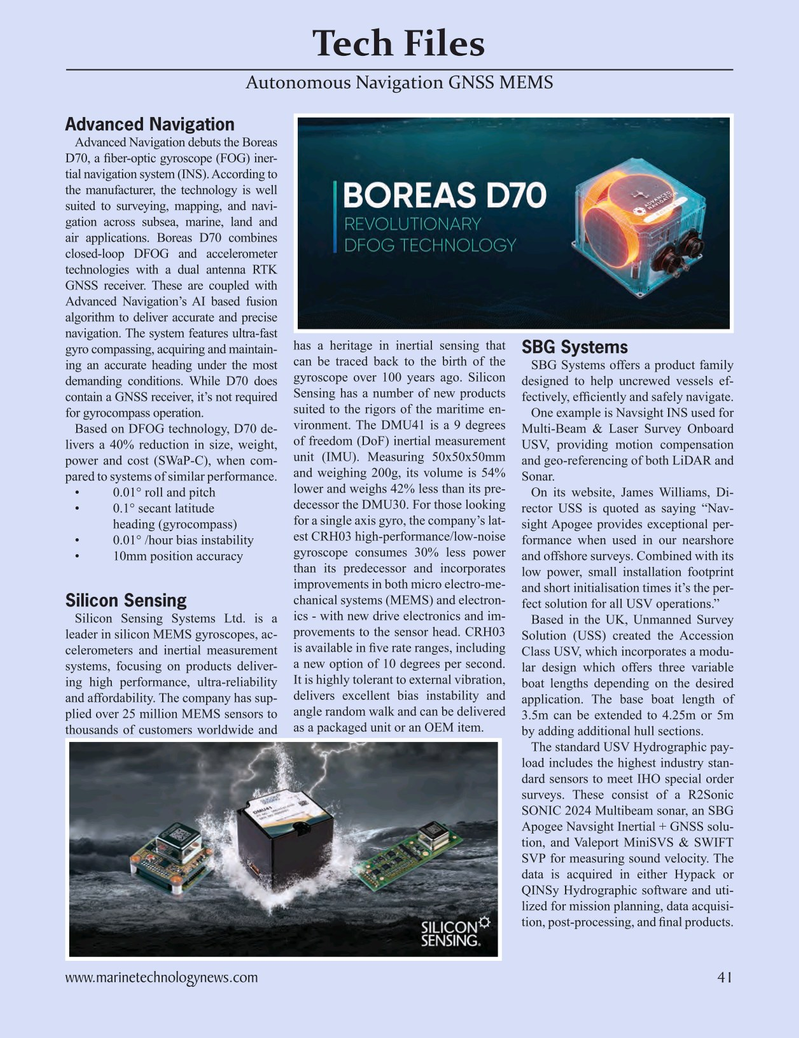
Page 41: of Marine Technology Magazine (January 2023)
Read this page in Pdf, Flash or Html5 edition of January 2023 Marine Technology Magazine
Tech Files
Autonomous Navigation GNSS MEMS
Advanced Navigation
Advanced Navigation debuts the Boreas
D70, a ? ber-optic gyroscope (FOG) iner- tial navigation system (INS). According to the manufacturer, the technology is well suited to surveying, mapping, and navi- gation across subsea, marine, land and air applications. Boreas D70 combines closed-loop DFOG and accelerometer technologies with a dual antenna RTK
GNSS receiver. These are coupled with
Advanced Navigation’s AI based fusion algorithm to deliver accurate and precise navigation. The system features ultra-fast has a heritage in inertial sensing that
SBG Systems gyro compassing, acquiring and maintain-
SBG Systems offers a product family ing an accurate heading under the most can be traced back to the birth of the demanding conditions. While D70 does gyroscope over 100 years ago. Silicon designed to help uncrewed vessels ef- contain a GNSS receiver, it’s not required Sensing has a number of new products fectively, ef? ciently and safely navigate.
suited to the rigors of the maritime en- for gyrocompass operation. One example is Navsight INS used for
Based on DFOG technology, D70 de- vironment. The DMU41 is a 9 degrees Multi-Beam & Laser Survey Onboard livers a 40% reduction in size, weight, of freedom (DoF) inertial measurement USV, providing motion compensation power and cost (SWaP-C), when com- unit (IMU). Measuring 50x50x50mm and geo-referencing of both LiDAR and pared to systems of similar performance. and weighing 200g, its volume is 54% Sonar.
lower and weighs 42% less than its pre- • 0.01° roll and pitch On its website, James Williams, Di- • 0.1° secant latitude decessor the DMU30. For those looking rector USS is quoted as saying “Nav- for a single axis gyro, the company’s lat- heading (gyrocompass) sight Apogee provides exceptional per- est CRH03 high-performance/low-noise • 0.01° /hour bias instability formance when used in our nearshore • 10mm position accuracy gyroscope consumes 30% less power and offshore surveys. Combined with its than its predecessor and incorporates low power, small installation footprint improvements in both micro electro-me- and short initialisation times it’s the per- chanical systems (MEMS) and electron-
Silicon Sensing fect solution for all USV operations.”
Silicon Sensing Systems Ltd. is a ics - with new drive electronics and im-
Based in the UK, Unmanned Survey leader in silicon MEMS gyroscopes, ac- provements to the sensor head. CRH03 Solution (USS) created the Accession celerometers and inertial measurement is available in ? ve rate ranges, including
Class USV, which incorporates a modu- systems, focusing on products deliver- a new option of 10 degrees per second. lar design which offers three variable ing high performance, ultra-reliability It is highly tolerant to external vibration, boat lengths depending on the desired and affordability. The company has sup- delivers excellent bias instability and application. The base boat length of plied over 25 million MEMS sensors to angle random walk and can be delivered 3.5m can be extended to 4.25m or 5m thousands of customers worldwide and as a packaged unit or an OEM item. by adding additional hull sections.
The standard USV Hydrographic pay- load includes the highest industry stan- dard sensors to meet IHO special order surveys. These consist of a R2Sonic
SONIC 2024 Multibeam sonar, an SBG
Apogee Navsight Inertial + GNSS solu- tion, and Valeport MiniSVS & SWIFT
SVP for measuring sound velocity. The data is acquired in either Hypack or
QINSy Hydrographic software and uti- lized for mission planning, data acquisi- tion, post-processing, and ? nal products. www.marinetechnologynews.com 41
MTR #1 (34-47).indd 41 1/24/2023 8:32:54 AM

 40
40

 42
42
